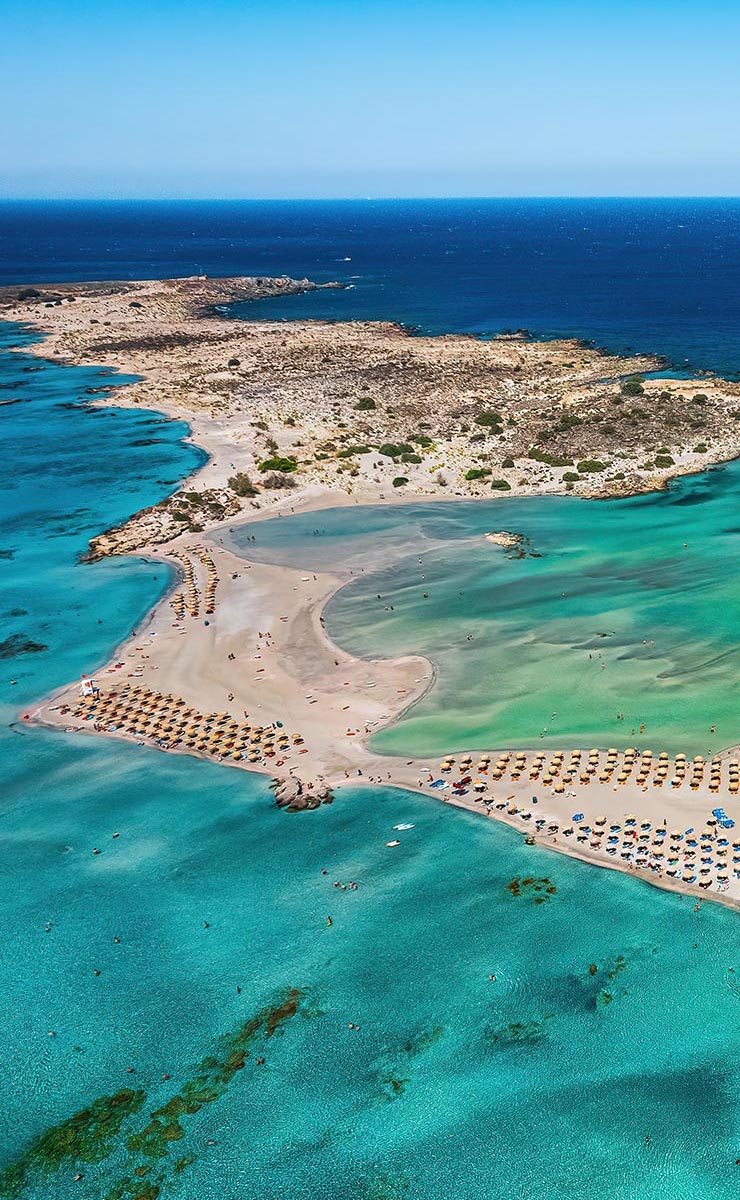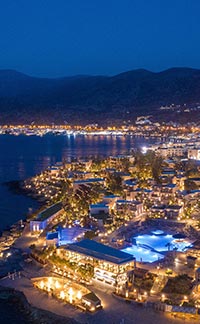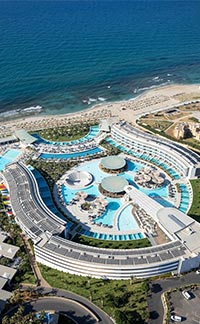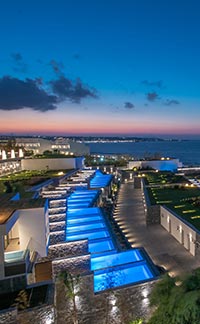Of all the regions and islands of Greece, Crete is most like its own country. This is partly because of its size: it's the largest island in Greece, and the 5th largest in the Mediterranean. (Corsica beats it out for 4th place by just a few thousand acres.) Another reason is its self-contained history: Crete is known as the birthplace of modern civilization, with a history going back 4,000 years.
The British writer Saki describes Crete as having "more history than it can consume locally." Ancient Crete was the first center of fashion, with an astonishing variety of design of women's costumes. much of which resembles modern female dress of the late 1800's, emphasizing narrow waists, large bosoms, and flared hips.
Near the capital of Heraklion, the Palace of Knossos was the thriving center of the life of the Bronze-Age Minoan Civilization until it was all wiped out by the Minoan Eruption and its subsequent tsunami when 60 cubic kilometers of rock- about half the land mass of the island of Santorini- was flung into the atmosphere just 120 kilometers to the north.
Crete is strategically located at the crossroads of Europe, Africa, and the Middle-East. The mainland Greeks called it the "Megalonisos-" the Great Island. Just 330 km north of the Egypt-Libya border, Crete has the mildest climate in Europe, the longest growing season in Greece, and the longest tourist season. Deep into September, when all other Greek resorts have long mostly closed their doors, Crete still enjoys a high season, with the waters of the Mediterranean still comfortably warm and many resorts more full than empty. Crete offers something for every pocketbook- whether it's 5-star luxury, or a humble campsite. Most of Crete's developed tourism happens on the north coast, while the south coast offers deserted beaches and quiet seclusion.
Best hotels in Crete
Nana Golden Beach’s heart is with the family. Recently renovated, this first-class Cretan resort offers a wide range of high-end facilities to satisfy guests at any age
Lyttos Mare is a massive, family friendly, 397-room 5-star resort on Crete’s north shore in Hersonissos. Newly opened in 2021, it is an architectural marvel. It’s shaped like a massive letter omega (Ω), with the open end facing the sea
This new luxury five-star resort caters to the most demanding and discerning clientele, offering its unique architectural features, design, premium spa facilities, wide range of VIP services, and the unparalleled beauty of its seaside setting
The pace of life in Crete, despite its developed tourist infrastructure, is still relatively unhurried. Reading a little beforehand about some of the lifestyles and traditions of Crete will go a long way towards making your stay there that much richer. Cretans are proud of their reputation as a people whose word is their bond, which filters down to attentive staff wherever you stay. The strong Eastern Orthodox tradition of Crete lends itself to lively, colorful festivals all during the calendar year.
Geography
Crete is long and narrow, with a shape like a west-facing, double-horned, wingless dragon. It has mountains running east and west along its length, dividing the island into northern and southern sections. The largest cities- Heraklion and Chania among them- are on the north coast. In the west, the Lefka Ori (White Mountains), in the regional unit of Chania, has more than 40 peaks over 2,000 meters high. Snow sometimes stays on the peaks till June. The slopes of the mountains are riven with spectacular gorges, most notably Samaria Gorge. An hour south of Chania, at 16 km in length, Samaria Gorge packed with dramatic scenery and geological formations. This steep-walled gash in the earth is the longest gorge in Europe. With the trailhead only 16 km north of Crete's south coast, it is a stunning downhill walk to the village of Chora Sfakion on the south coast, one of the best places to stay on that side of the island.
Sunbathers and swimmers begin showing up as early as March, with temps up by May reaching ideal levels- earlier than elsewhere in Greece. By June the island is full of thousands of vacationers.
Family Outings
For a family-style outing, Crete has a lot of water parks, including Acqua Plus just outside of Heraklion, which advertises itself as the biggest and best on the island, Star Beach Village, east of Heraklion about 15 km, and Limnopoulis near Chania. Crete also has some nice aquariums, including Cretaquarium Thalassocosmos in Gournes, 10 km east of Heraklion, and Aquaworld Aquarium & Reptile Rescue Centre in Hersonissos, another 10 km east of Gournes.
Beaches and Other Points of Interest
Crete has about a thousand miles of coastline, and hundreds of beautiful beaches. Much of the northern coast of Crete has a highly developed tourist infrastructure, which is perfect for those who want to go Club Med. For those who want a taste of the traditional, the villages on island's east and west ends provide that, as well as a lot of the south coast.
Chania has many Blue Flag beaches and a richly historic Old Town. The nearby Akrotiri peninsula, which from space looks rather like the knob on the head of the wingless dragon, features two fascinating monasteries: Agia Triada, and Gouverneto, both built using Renaissance-style architectural motifs and virtually unchanged since then. Bear Cave (Arkoudospilios) near Gouverneto has a stalagmite in the shape of that animal, and is thought to have been a center of cultic worship of Artemis. Chania and Rethymno have loads of medieval, Ottoman, and Venetian architecture. In addition, there are hundreds of Byzantine-era churches decorated with exquisite wall frescoes
Beaches in Heraklion are often used as places for party-goers to recover from the previous night's revelry and recharge their batteries for another evening of partying. Heraklion also has the Heraklion Archeological Museum, world's greatest repository of Minoan artifacts, while in nearby ( 5 km south) Knossos, which dominated the island from 1900 to 1375 BC, palace complexes have been restored.
Gourtyn, 35 km south of Heraklion (and 15 km north of Crete's south coast), has an open-air museum and 9th century, BC ruins. Homer mentions Gourtyn, and Plato spoke favorably of it, and during its Hellenistic heyday (the last 3 centuries BC) it was the most powerful city on Crete.
About 20 km west of Gourtyn, Phaistos, said to be founded in 2000 BC by legendary King Minos of Knossos, was as prominent as Gourtyn, only at an earlier time period. It was one of the 3 cities (the others being Knossos and Kydonia) united under King Minos.These 3 cities, along with Malia and Zakros, were nominated as a UNESCO World Heritage sites in 2014 by UNESCO's Greek delegation as "Minoan Palatial Centers.".
Phaistos, sited on the eastern crest of a coastal ridge overlooking the Mesara Plain, has extensive ruins, with the palace of Agia Triada on the western end of the ridge.
Hersonissos is famous for its clubs and night life, as well as is nearby Malia. The night clubs are full of young partiers from northern Europe, especially Belgium, Holland, Ireland and the UK who dance in the streets at night and soak up the sun at the nearby beaches during the day.
More Beaches Elsewhere on Crete
Matala, in the center of Crete's south coast, was a famous haunt of hippies in the late 60's-early 70's until the Junta kicked them out. It is a quiet place with nice beaches and ancient man-made caves.
Vai, on the east coast, features a very nice forest of palms (the largest in Europe), and bright white sand. This palm beach is very popular with tourists. The legend is that either pirates, or Phoenicians, came ashore at Vai, ate dates, and threw the stones on the ground which grew to this palm forest of 4,500 trees. Vai is where the hippies came after they were kicked out of Matala.
Elafonissi, 300 km from Vai,is an islet off the southwest corner of the island, and one of Crete's most popular beaches. The main beach itself is on the mainland. The sand has an unusual pink cast to it. Waters are shallow which makes it safe for small children.
Balos Beach, north of Elafonissi on the northwest shore of Crete, is said to have been the haunt of pirates. It features a nice beach, beautiful aquamarine water, some decent hotels, and some ruined fortifications.
Crete is the kind of place which attracts return visitors year after year, and some even end up buying houses and retiring there. It is a spectacular island with its own distinct culture. Crete is Greek, but has its own cultural identity due to its rich past. A visit there will leave you with unforgettable memories of one of Greece's most beautiful and unique places.















